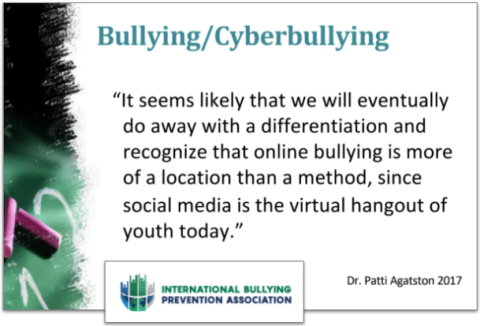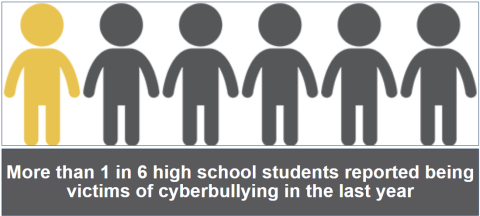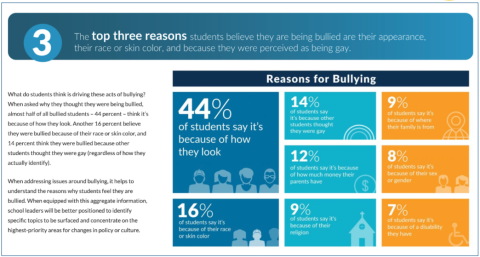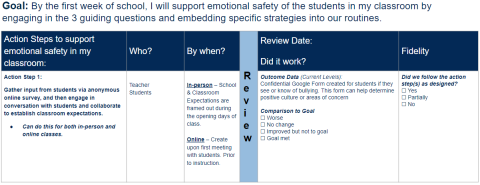
Click the link below for the
Cyberbullying Prevention module
The full version of the module is in the downloadable PDF above. An accessible text version is below.
Support Success with Social-Emotional-Behavioral Health (SEBH) Supports - Cyberbullying Prevention
This module will increase educators’ awareness of cyberbullying. Defining what it is, how it affects students, when schools are to become involved, and most importantly, how to take a proactive, preventative approach to protect students. Other modules are available through the Support Success with SEBH Supports.
Purpose & Objectives
This is one of a set of modules that highlight critical considerations and provide universal strategies to support the social-emotional-behavioral health of staff, students, and families during in-person and/or online learning.
Each module is:
- a “jump-start” to key considerations, with less focus on systemic changes
- designed to be completed in
30 minutes or less - for educators/teachers
- self-paced but may be facilitated
- optional; educators may use one or more depending on need
Supporting Social-Emotional-Behavioral Health
Staff, family, and student emotional well-being is integral to effective instruction and student engagement. Planning for this support is critical to ensure adults and learners are ready to learn.
Teachers with Strong Social-Emotional Competence...
- Have less burnout
- Have stronger student relationships
- Regulate their own emotions
- Are social-emotional role models
Students with Strong Social-Emotional Competence...
- Have increased achievement
- Have improved attitudes
- Have less emotional distress
- Have fewer conduct concerns
Alignment to State Priorities and Goals
State Priority: Creating a Safe, Healthy, and Welcoming Learning Environment
- Goal: All Iowa schools will work with their learners to foster a culture and climate in which they feel safe and supported, and bullying and harassment do not exist.
- Goal: All learners will have access to mental health services and supports in their schools and communities.
- Goal: All schools will create environments that develop social, emotional, and behavioral health.
- Goal: All schools will develop physical health for students through structured school programs (e.g., food and nutrition, physical education, wellness programs, etc.)
Connecting to your work
How do these recommendations connect to your work?
The practices outlined in the following modules align to:
- Best practices detailed within many policy expectations for schools
- Evidence Based Practices (EBPs) for SEBH
- Universal Supports for SEBH within an MTSS
The purpose of these resources is to apply EBP for SEBH within the context of a variety of learning contexts including in-person, online, and virtual.
Cyberbullying - Awareness and Prevention
Objectives:
- Define and understand the impact Cyberbullying has on the learning environment.
- Provide awareness to Prevent Cyberbullying.
- Identify resources to build positive digital climate and culture.

"As access to technology and electronic communication increases, and the social media landscape evolves, the environments in which an individual can experience bullying expands.
Therefore, bullying no longer begins and ends with school bells; it is now entrenched within one’s physical and electronic boundaries."
Chad A. Rose, PhD
Key Terms
Cyberbullying: “Willful and repeated harm inflicted through the use of computers, cell phones, and other electronic devices.” Cyberbullying Research Center
Permanence: Because of its persistence and its permanence, cyberbullying can be extremely hurtful and very difficult to stop or even locate the perpetrator. Inappropriate pictures/videos are likely to fall into the wrong hands in seconds.
Nexus: There must be a close connection, a direct link, to the virtual or brick & mortar school learning environment for school’s to be legally obligated to intervene, investigate, and give possible consequences to a student(s) who cyberbullies.
Primary Prevention: A systematic process that practices and promotes safe, healthy environments and behaviors in order to reduce the likelihood or frequency of bullying or cyberbullying from occurring.
Digital Citizenship: Responsible use of technology by anyone who uses computers, the Internet, and digital devices to engage with society on any level.
Impact of Cyberbullying
Great video to share with your students to begin a cyberbullying conversation!
Discussion questions:
- What did you notice about the way in which cyberbullying was portrayed in this video?
- How did watching this video make you feel?
- What new learning or perspective did this video provide for you?

Cyberbullying and Suicide
“Youth who experienced traditional bullying or cyberbullying, as either an offender or a victim, had more suicidal thoughts and were more likely to attempt suicide than those who had not experienced such forms of peer aggression.”
Bullying, Cyberbullying and Suicide
by Sameer Hinduja and Justin W. Patchin
Cyberbullying: Three Guiding Questions
- What is cyberbullying and how is it different than traditional forms of bullying?
- How will the teacher and their students know when cyberbullying has impacted the learning environment?
- What prevention strategies can be put into place for each student?
Cyberbullying Defined:
Iowa Code 280.28 includes electronic use as a means to bully/cyberbully.
- Willful: The behavior has to be deliberate, not accidental.
- Repeated: Bullying reflects a pattern of behavior, not just one isolated incident.
- Harm: The target must perceive that harm was inflicted.
- Computers, cell phones, and other electronic devices: This, of course, is what differentiates cyberbullying from traditional bullying.
Source: Cyberbullying Research Center
Cyberbullying Includes:
- Imbalance of power – a student disseminates an embarrassing picture via social media without a person's knowledge, consent, or awareness.
- Repetition – A student posts hateful comments about a peer on social media. After this same student gets caught, she continues to post anonymously and encourages others to post hateful comments towards this same peer.
- Intent - A student posts a compromising picture of a peer on social media with a caption that is extremely hurtful.
Repetition can occur immediately with mass sharing on digital platforms.
How is Cyberbullying different from traditional forms of bullying?
- Victims may not know who their perpetrator is or why they are being targeted.
- Cyberbullying goes viral immediately upon posting - repeated behavior is automatic.
- It is often much easier for the perpetrator to do and say extremely harmful things because they do not see the reaction/harm imposed upon the target.
- Most adults do not have the technological know how to keep track of what teens are doing online.
Source: Hinduja & Patchin, 2011
Why may cyberbullying be of greater concern from this point on in society?
- Cyberbullying is an increasing problem since an increasing number of kids are using and have embraced interactions via computers and cell phones.
- Two-thirds of youth go online every day to work, keep in touch with friends, play games, learn about celebrities, share their digital creations, and much more.
- The fact that teens are connected to technology 24 by 7 means that they are susceptible to victimization (as well as become bullies towards others) around the clock.
- Apart from a measure of anonymity, it is easier to be hateful when using typed words rather than spoken words.
Source: End to Cyberbullying Organization
Put Away Labels Examine Behaviors
- Bullying is a Dynamic Process that can shift depending on time and context.
- In one context a person may be a victim, in another, a bully.
- It’s critical to know the Warning Signs of the Cyberbullying Dynamic.
Warning Signs of Victimization
Possible Signs or Symptoms:
- Unexpected change in device use
- Appears nervous about attending school or when using device(s)
- Changes in mood or behavior (especially after using devices)
- Changes in student performance - grades, activities, work habits
- Becomes abnormally withdrawn from friends and family
- Changes in sleeping or eating habits
- Avoids discussions about what they are doing online
- Frequently calls or texts from school requesting to go home ill
- Desires to spend more time with parents rather than peers
- Becomes unusually secretive, especially for online activity
Warning Signs of Perpetration
- Quickly Switches Screens or hides their device when adult is nearby
- Gets unusually upset if they can't use their device(s)
- Laughs excessively while using their device(s) - hides it from others
- Increased behavioral issues/disciplinary actions at school/homework
- Demonstrates increasing insensitivity or callousness toward others
- Appears overly conceited as to their technological skills and abilities
- Appears overly concerned with popularity or continued presence in a particular social circle or status
- Is increasingly withdrawn or isolated from family
- Seems to be using multiple online accounts
Students Don’t Always use the Term, “Cyberbullying”
Outing/Doxing: Openly revealing sensitive or personal information or images about someone (without their consent) for malicious purposes.
Cyberstalking: Threats of physical harm directed towards the victim.
Fraping: Using another student’s social media account to post inappropriate content.
Masquerading: Creating a fake email, social media profile, and selecting a new identity or photos to fool the victim. The bully tends to be someone the victim knows quite well.
Dissing: Spreading cruel information about their target through public posts or private messages to either ruin their reputation or relationships.
Trolling: Posting provocative comments online. Usually, such actions come from people we don’t even know or who are following you.
Flaming: Provoking someone through comments and direct messages.
Legal Obligation of Schools & Cyberbullying
Online Learning has OPENED the door WIDE to invite opportunities for cyberbullying right into the classroom and beyond…
NEXUS: Legal term that describes when schools have an obligation to investigate and STOP Cyberbullying.
“A NEXUS occurs when there is a close connection, a direct link, to the virtual or brick & mortar learning environment. Schools must also investigate and implement consequences and/or interventions to the student(s) who cyberbullies another student(s).”
~Carol Greta, Attorney, Iowa Department of Education 2005
Students’ 1st Amendment Rights Do Not Allow for Bullying/Cyberbullying
Tinker v. Des Moines 1969 - Student’s Have Free Speech:
- Supreme Court landmark ruling for Students’ Freedom of Speech, “Students do not shed their constitutional rights at the schoolhouse gate.”
- School personnel have the burden of demonstrating that the speech or behavior resulted in (or reasonable likelihood of resulting in) a substantial interference.
Kowalski v. Berkeley County Schools 2011- Bullying/Cyberbullying is Not Permitted:
- Kara Kowalski created an online profile disparaging a peer: “S.A.S.H.” (Students Against Shay’s Herpes). The School District suspended Kowalski for 10 days. She took the school to court.
Fourth U.S. Circuit Court of Appeals Ruled in Favor of the School:
- “Kowalski used the Internet to orchestrate a targeted attack on a classmate, and did so in a manner that was sufficiently connected to the school environment as to implicate the School District’s recognized authority to discipline speech.
School Actions:
- School becomes involved once the educational environment for the student is affected - hostile school environment
- There must be a close connection - a nexus - to school for school officials to be able to suspend cyberbullies.
- Freedom of speech must be taken into account.
- The school must demonstrate legitimate pedagogical concerns before courts will allow schools to take action that removes a student from school.
For More information, refer to the Iowa Department of Education: Bullying Checklist
Know Your School’s Anti-Bullying Policies & Practices
Do I know...?
- My district’s Anti-Bullying Policies & Procedures
- Where the Bullying/Harassment information is located on my district website
- The Administor who conducts investigations
- The process for these investigations
- Where to locate Anti-Bullying Complaint Forms for parents and students to complete
Intervention Considerations
- Targets are often perceived as being different than others
- Characteristics the person has NO control over, and cannot change
- Students who bully, are bully/victims or are targeted, may have Skill Deficits that need to be addressed and taught.
- Make decisions and policies that are inclusive of all races, cultures, disabilities, and classes.
Cyberbullying Prevention: Digital Citizenship is Key!
Adopt/Influence School & Civic Policies
- Teach digital citizenship/expectations.
- Cyberbullying is the school’s responsibility when a substantial disruption occurs in the learning environment.
- Avoid the urge to “criminalize” all forms of cyberbullying.
- Know School Policy on Discipline* for Cyberbullying.
- Know School Policy on communicating electronically with students.
*Discipline means to teach, instruct, and learn positive behaviors!
Cyberbullying Research Center Digital Citizenship Activities for Educators
Expectations Matrix
Below is a great model for online expectations.
South Hardin Zoom Expectations
Be Safe
- *Use the features of zoom appropriately
- *Keep links and passwords to zoom for you only
Be Respectful
- *Listen to the speaker; put all other electronics away (phones, computer or other electronic games)
- *Use kind words and actions
- *Respect others’ learning
- *Take turns speaking
Be Responsible
- *Follow directions from adults
- *Stay on task
- *Use chat for positive class related comments only
- *Come prepared with requested materials
Do Your Best
- *Stay muted unless it is your turn to talk or otherwise directed
- *Participate
- *Keep your background simple, a blank wall or door
- *Stay in one place; refrain from walking places with your device
- *Do your best to keep family members from being a distraction in camera’s focus
Cyberbullying Prevention: Empower Students to Speak Up!
Strengthen Students’ Knowledge, Empathy, & SEL Skills
- Create a culture of personal responsibility.
- Provide opportunities for students to reflect on biases that may lead to conflict.
- Reinforce the active bystander approach.
- Teach that reaching out for help is a sign of strength.
- Empower students to support targets of cyberbullying.
- Provide Confidential Google Reporting Form for students.
- Teach students the difference between “Social Mistakes,” “Joking,” and Cyberbullying.
Think Abouts….Are you purposeful in teaching and creating equity?
Create a Positive Classroom Culture Where Students are Empowered to Support Each Other!
Cyberbullying Prevention: Communicate & Collaborate!
Engage Parents and Community:
- Create partnerships with all student families: Race, Religion, Culture, Gender, Entitled Students.
- Realize that in the era of cyberbullying, home and school are no longer two separate entities in the minds of digital students.
- Inform parents/guardians on how to be involved in their children’s online lives.
- Ensure equitable access to all resources and tools.
Think Abouts... Who is invited for community input? Is it always the same people?
Children are the Priority, Change is the Reality, Collaboration is the Strategy!
Cyberbullying Prevention: Be Informed!
Willingness to Change & Modify Practices
- Adopt non-punitive responses to minor cyberbullying infractions, i.e., Restorative Justice; SEL Interventions.
- Review, adjust, and communicate formal complaint process consistent with board policies and/or Title IX.
- Identify disproportionality in data among marginalized groups.
- If behaviors are severe (i.e, threats, stalking, harassment), assess and consider partnering with law enforcement.
What is one thing I can do this week to become better informed?
What do Prevention Practices of Cyberbullying look like in different learning contexts?
On-site
- Proactive Approach
- Define Cyberbullying
- Partner with students to create online learning expectations
- Explain School District’s stance against Bullying/Harassment
- Encourage student voice, creating positive culture
- Create Confidential Google Form for student reporting
- Share all above information with parents
Online
- Utilize On-Site Strategies
- Prior to virtual instruction, post, review Expectations
- Turn off Individual Chat
- Allow students to keep camera off or create neutral backgrounds
- Communicate with Administration & Technology Support if you suspect a problem
- Review regularly
Reflections: Equity Considerations

Action Plan
This slide shows an example action plan for supporting Cyberbullying Prevention.

Follow-up Activities (Optional)
The following activities are suggested to support implementing these practices within your school:
Activity 1 (Optional)
- Have you ever posted, texted, or emailed someone when you were hurt or angry? What happened?
- Consider some ways you can
cool down when you’re fired up.
What works for you?
Source: Words Wound by Patchin and Hinduja
Activity 2 (Optional)
- Describe a recent cyberbullying incident that you saw.
- What happened?
- What did you do?
- Later, did you feel like you could have or should have done more?
- Why or why not?
- Why do you think people are afraid to step up and do something when they see cyberbullying happening?
- What do you think could give more people the courage to be upstanders?
Source: Words Wound by Patchin and Hinduja
Resources
- Cyberbullying Research Center
- Cyberbullying - What Teachers Can Do
- Teacher's Essential Guide to Prevent Cyberbullying - Contains Videos
- Cyberbullying - Student Experiences with Reporting
- CASEL School Guide Resources
- 10 Forms of Cyberbullying
- What is Cyberbullying?
- ORID - Questioning & Facilitation Process
- PBIS - Creating a Remote Learning Behavior Matrix
- Patchin, J., and Hinduja, S. “Words Wound” 2014, Minneapolis, MN Free Spirit Publishing